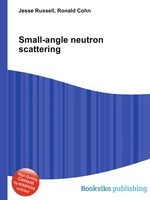Small-angle neutron scattering
Jesse Russell Ronald Cohn
бумажная книга
High Quality Content by WIKIPEDIA articles! Small angle neutron scattering (SANS) is a laboratory technique, similar to the often complementary techniques of small angle X-ray scattering (SAXS) and light scattering, used for investigations of structure of various substances, with spatial sensitivity of about 1 - 1000 nm. These are particularly useful because of the dramatic increase in forward scattering that occurs at phase transitions, known as critical opalescence, and because many materials, substances and biological systems possess interesting and complex features in their structure, which match the useful length scale ranges that these techniques probe. The technique provides valuable information over a wide variety of scientific and technological applications including chemical aggregation, defects in materials, surfactants, colloids, ferromagnetic correlations in magnetism, alloy segregation, polymers, proteins, biological membranes, viruses, ribosome and macromolecules. There are numerous SANS instruments available worldwide. While analysis of the data can give information on size, shape, etc., without making any model assumptions a preliminary analysis of the data can only give information on the radius of gyration for a particle using Guinier`s equation.


